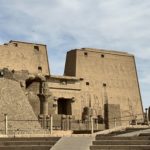order Pregabalin online  Early morning we left our overnight stop and headed to Edfu where we arrived about 8:30 AM. Before breakfast I was finally able to catch a sunrise photo! Horse-drawn carriages waited for us along the waterfront at Edfu this morning for the ride through this dusty small river town to the well-preserved temple of Horus. The largest temple dedicated to the falcon god, it is notable for the two stone falcons at its entrance and the huge relief figures on its façade.
Early morning we left our overnight stop and headed to Edfu where we arrived about 8:30 AM. Before breakfast I was finally able to catch a sunrise photo! Horse-drawn carriages waited for us along the waterfront at Edfu this morning for the ride through this dusty small river town to the well-preserved temple of Horus. The largest temple dedicated to the falcon god, it is notable for the two stone falcons at its entrance and the huge relief figures on its façade.

buy gabapentin without prescription Edfu Temple
The temple was built in the Ptolemaic Kingdom between 237 and 57 BC, but was literally lost beneath the sands of time as drifting desert sand and river silt deposited by the Nile buried it to a depth of 40 feet. Local inhabitants built their homes over it and, by 1798, when the temple was discovered by a French expedition, only the upper portions of the pylons were visible. The temple is of great interest because, despite relatively recent construction, it imitates much older Pharaonic designs. The imposing 118 foot high first pylon is decorated with scenes of Ptolemy XII defeating his enemies in front of Horus and Hathor. Two elegant black granite statues of Horus flank the entrance to the pylon, which leads to a large colonnaded court and the first hypostyle hall. Behind this is a second smaller hypostyle hall with chambers off to the side for gifts to the god before they were taken to the hall of offerings. Stairs from the hall of offerings lead to the roof (inaccessible) but the walls of the staircase are decorated with scenes from the New Year Festival a ritual celebrated in temples all over Egypt where priests carry the statue of the temple god to the roof to be revitalized by the sun. Beyond the hall of offerings is the sanctuary of Horus with its black granite shrine which contains a model of Horus’ sacred barque. Southwest of the temple lie the remains of Horus birth house.
Maged explained how the standard design of the temples is a physical representation of the ancient Egyptian story of creation. Why, for example, as you enter farther into the temple, the ceiling slopes downward and the floor slopes upward. The temple is of stone and usually surrounded by a mud brick wall so that if the Nile flooded and damaged the surrounding wall the wall could be easily or at least quickly replaced. The palaces of the kings, residences of the notables and priests, etc. were all constructed of mud bricks, which is why we haven’t found any remains of them. The mamesi or birth house was only unearthed twenty years ago and continuing excavation work is being funded by National Geographic and Discovery.
As soon as we were back on board, the Nebu took off to return to Luxor through the Esna lock.
The Temple of Edfu. The first pylon is decorated with large reliefs.
Come along on the horse drawn carriage ride from Edfu temple back to the Nebu (Nile River boat).
After lunch, Mike took a tour of the ship’s kitchen. I had a massage at the onboard spa.
At the port talk this evening, Maged and Hazem covered life in Egypt today: the education system, the economic system, the government, marriage customs, etc.






































